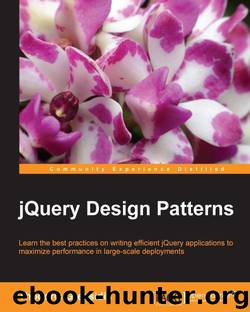jQuery Design Patterns by Thodoris Greasidis

Author:Thodoris Greasidis [Greasidis, Thodoris]
Language: eng
Format: epub
Publisher: Packt Publishing
Published: 2016-02-25T23:00:00+00:00
As we have already seen in Chapter 1, A Refresher on jQuery and the Composite Pattern, the primary way to use the $() function is to invoke it with a CSS selector as a string parameter and in turn it will retrieve the matching page elements and return them in a Composite Object. On the other hand, when the $() function detects that it has been invoked with a string parameter that looks like a piece of HTML, it works as a DOM element Builder. This overloaded way of invoking the $() function bases its detection on the assumption that the provided HTML code starts and ends with the inequality symbols < and >:
init = jQuery.fn.init = function( selector, context ) { /* 11 lines of code */ // Handle HTML strings if ( typeof selector === "string" ) { if ( selector[ 0 ] === "<" &&selector[ selector.length - 1 ] === ">" &&selector.length >= 3 ) { // Assume that strings that start and end with <> are HTML // and skip the regex check match = [ null, selector, null ]; } /*...*/ // Match html or make sure no context is specified for #id if ( match && ( match[ 1 ] || !context) ) { // HANDLE: $(html) -> $(array) if ( match[ 1 ] ) { /* 4 lines of code */ jQuery.merge( this, jQuery.parseHTML( match[ 1 ], /*...*/ ) ); /* 16 lines of code */ return this; }/*...*/ }/*...*/ }/*...*/ };
Download
This site does not store any files on its server. We only index and link to content provided by other sites. Please contact the content providers to delete copyright contents if any and email us, we'll remove relevant links or contents immediately.
The Mikado Method by Ola Ellnestam Daniel Brolund(20603)
Hello! Python by Anthony Briggs(19899)
Secrets of the JavaScript Ninja by John Resig Bear Bibeault(18208)
Dependency Injection in .NET by Mark Seemann(18108)
The Well-Grounded Java Developer by Benjamin J. Evans Martijn Verburg(17575)
Kotlin in Action by Dmitry Jemerov(17185)
Sass and Compass in Action by Wynn Netherland Nathan Weizenbaum Chris Eppstein Brandon Mathis(13266)
Secrets of the JavaScript Ninja by John Resig & Bear Bibeault(11381)
Jquery UI in Action : Master the concepts Of Jquery UI: A Step By Step Approach by ANMOL GOYAL(9387)
Svelte with Test-Driven Development by Daniel Irvine(8139)
Test-Driven Development with PHP 8 by Rainier Sarabia(7889)
Layered Design for Ruby on Rails Applications by Dementyev Vladimir;(7707)
Web Development with Django by Ben Shaw Saurabh Badhwar(7216)
React Application Architecture for Production by Alan Alickovic(6899)
Software Architecture for Web Developers by Mihaela Roxana Ghidersa(4980)
Audition by Ryu Murakami(4888)
Accelerating Server-Side Development with Fastify by Manuel Spigolon Maksim Sinik & Matteo Collina(4837)
Solidity Programming Essentials by Ritesh Modi(4565)
Build Your Own Web Framework in Elixir by Aditya Iyengar(4439)
